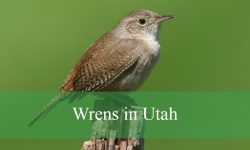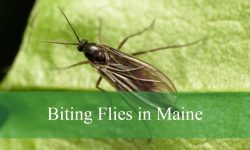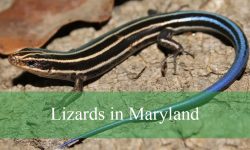Living in Texas, it doesn’t take long to notice just how common and diverse doves are across the state. From quiet backyards in the suburbs to wide-open ranch lands, these graceful birds seem to show up everywhere. Over the years, I’ve come to recognize and appreciate the many types of doves in Texas, each with its own habits, calls, and preferred habitats.
Some doves thrive in urban settings, nesting near homes and feeders, while others prefer the brushlands of South Texas or the rugged terrain out west. A few species are common sights year-round, while others appear only occasionally, making them a treat for seasoned birders. No matter the region, the types of doves in Texas offer a unique glimpse into the state’s natural diversity.
This article brings together 16 remarkable types of doves in Texas, complete with photos and key identification details. From the familiar Mourning Dove to rare visitors and even extinct species that once filled the skies, this guide reflects both the everyday and extraordinary of Texas birdlife.
Different Types of Doves in Texas
Mourning Dove (Zenaida macroura)
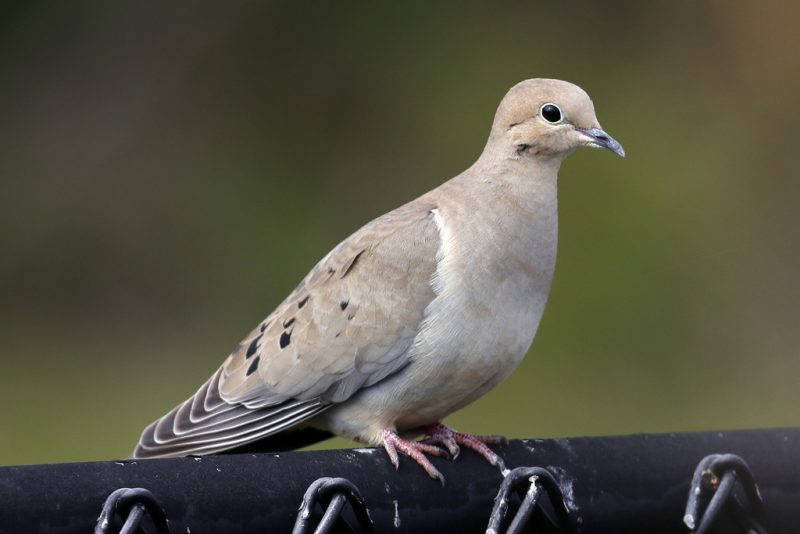
The Mourning Dove is one of the most recognizable birds in North America, known for its soft, mournful cooing and streamlined, light brown body. It has long, pointed tail feathers with white edges and black spots on its wings. Adults typically measure about 12 inches in length and are slender with small heads and a graceful flying pattern.
These doves are commonly seen perched on telephone wires, fence posts, or foraging on the ground in open fields and backyards. Their flight is swift and direct, and they produce a distinctive whistling sound with their wings when taking off. Mourning Doves are monogamous and often return to the same nesting sites, typically building flimsy nests in shrubs or trees.
In Texas, Mourning Doves are abundant statewide and are present year-round. They thrive in both urban and rural areas, from farmlands and suburbs to city parks. As one of the most hunted game birds in the United States, especially during dove season in Texas, their population remains stable due to their high reproduction rate and adaptability.
White-winged Dove (Zenaida asiatica)

White-winged Doves are medium-sized doves with a striking white stripe along the edge of each wing, which is especially visible in flight. Their overall plumage is light brown or grayish-tan, with a blue ring around the eye and a short, squared tail. These doves are slightly larger and bulkier than Mourning Doves.
They are social and often seen in large flocks, particularly around food sources such as seed feeders or fruit-bearing trees. White-winged Doves produce a distinctive hooting call and have strong, direct flight patterns. They feed on grains, seeds, and fruits and are especially attracted to agricultural areas like sorghum and sunflower fields.
In Texas, White-winged Doves are especially common in central and southern regions, including San Antonio, Austin, and the Rio Grande Valley. Their population has expanded in recent decades due to urbanization and increased food availability. They are also a popular game bird during the dove hunting season in Texas.
Eurasian Collared-Dove (Streptopelia decaocto)
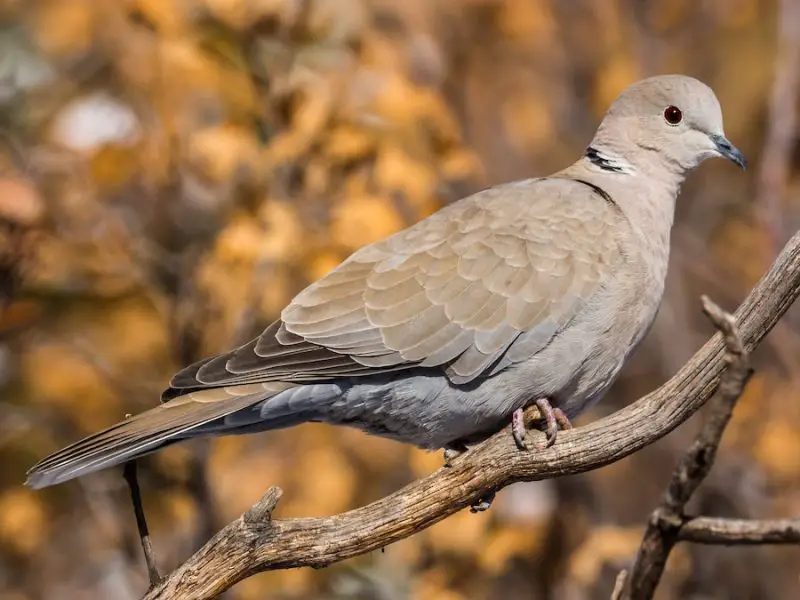
The Eurasian Collared-Dove is a pale gray dove with a characteristic black crescent-shaped collar on the back of its neck. It is slightly larger than the Mourning Dove and has broad wings and a squared tail tipped with white. This species has dark eyes and a subtle pinkish hue on the chest.
Introduced to North America in the 1980s, this non-native species has rapidly expanded its range and is now common across much of the United States, including Texas. It is often found around human habitation—especially in suburban neighborhoods, grain silos, and farmyards. The bird’s call is a repetitive, rhythmic “coo-COO-coo.”
In Texas, Eurasian Collared-Doves are widespread and well established, particularly in towns and rural areas with ample food sources. They nest in trees, utility poles, and buildings, and their adaptability to human environments has made them a permanent part of the state’s avian landscape.
Inca Dove (Columbina inca)
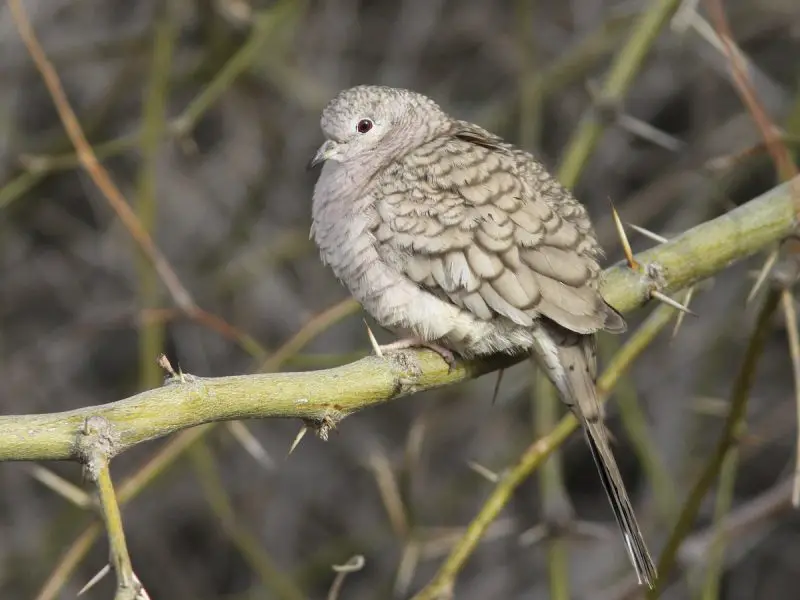
The Inca Dove is a small, slender bird with a scaled appearance created by the dark edges on its pale brown feathers. It has a long, narrow tail with white edges and a soft cooing voice. Its plumage helps it blend in well with dusty, arid environments, giving it excellent camouflage on the ground.
This species prefers open, dry habitats with scattered trees and shrubs. It is frequently seen walking on sidewalks, driveways, or pecking around bird feeders in urban areas. Inca Doves are gentle and often form small flocks. They have an unusual habit of huddling together in “dove pyramids” during cold weather to retain warmth.
In Texas, Inca Doves are most common in central and southern regions, where they inhabit residential areas, parks, and dry scrublands. They are year-round residents and can thrive in both urban and semi-rural settings, particularly where dense vegetation or brushy cover is available for nesting and roosting.
Rock Pigeon (Columba livia)

Rock Pigeons are robust, chunky birds with short necks and a wide range of plumage colors, though the most common type is gray with two black wing bars and iridescent green and purple around the neck. Originally native to Europe, North Africa, and western Asia, they are now found in cities worldwide.
These pigeons are highly adaptable and are most often seen roosting on ledges, bridges, and buildings. They forage on the ground in flocks, feeding on grains, seeds, bread, and human food waste. Their flight is strong and direct, and they are capable of long-distance navigation, which is why they were historically used as messenger pigeons.
In Texas, Rock Pigeons are primarily urban birds, thriving in downtown areas, rail yards, and agricultural facilities. They breed year-round in mild climates and often nest in man-made structures. Despite being considered pests in some places, they play an integral role in urban ecosystems and are a common sight in nearly every Texan city.
Common Ground-Dove (Columbina passerina)
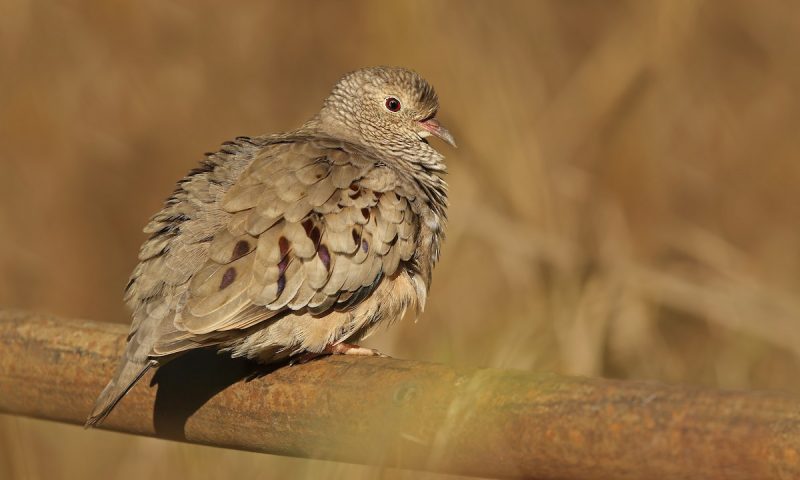
The Common Ground-Dove is the smallest dove species in Texas and North America, measuring just about 6.5 inches in length. It has a plump body, short tail, and scaly-looking plumage with a warm reddish-brown coloration and fine markings. Males often show a slight pinkish hue on the chest and bluish tones on the crown.
This species prefers dry, open areas with sparse vegetation such as scrublands, desert edges, and roadsides. True to its name, the Common Ground-Dove spends much of its time foraging on the ground, feeding primarily on seeds. Its call is a soft, repetitive “woot-woot-woot” that resembles a mechanical sound.
In Texas, these doves are found most frequently in the southern and western parts of the state, especially in arid regions. They are non-migratory and remain in their territories year-round. Their small size, secretive nature, and ground-hugging behavior often make them difficult to spot unless flushed.
White-tipped Dove (Leptotila verreauxi)

The White-tipped Dove is a medium-sized, ground-dwelling dove with a pale gray head, brown back, and a white-tipped tail that gives the species its name. Its eyes are surrounded by a bright blue orbital ring, and it walks with a slow, deliberate gait. This dove has a soft, echoing “whoo-oo” call often heard deep in dense brush.
White-tipped Doves favor thick, subtropical woodlands and brushy habitats, often avoiding open spaces. They forage quietly on the ground for seeds and fallen fruits and are more often heard than seen due to their shy nature. Unlike other doves, they rarely gather in large groups, preferring solitary or paired behavior.
In Texas, they are primarily restricted to the Lower Rio Grande Valley, especially in protected areas such as the Santa Ana National Wildlife Refuge and Bentsen-Rio Grande State Park. Their distribution in the U.S. is limited, making them a specialty species for birders visiting South Texas.
Red-billed Pigeon (Patagioenas flavirostris)
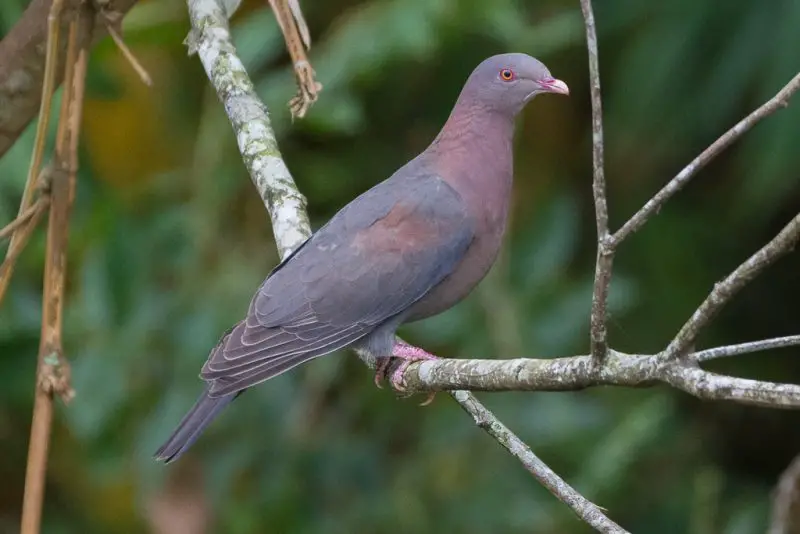
The Red-billed Pigeon is a large, stocky pigeon with a deep purplish-gray body, broad wings, and a distinctive bright red bill tipped in yellow. It also has red legs and a maroon-colored head and chest that contrast with its slate-gray back. This species is noticeably larger than most other pigeons in the region.
These pigeons are typically found in riparian woodlands and subtropical forests. They are shy and often remain hidden in tree canopies, where they feed on fruits and berries. Their calls are deep and resonant, echoing through the forested areas they inhabit. They are monogamous and build stick nests high in trees.
In Texas, Red-billed Pigeons are confined to the extreme southern tip of the state, particularly along the Rio Grande near places like Roma, Salineño, and the Falcon Dam area. They are considered rare and local in the U.S., drawing attention from birdwatchers hoping to spot this tropical species.
Ruddy Ground-Dove (Columbina talpacoti)

The Ruddy Ground-Dove is a small dove with a warm rufous or reddish-brown body and subtle spotting on its wings. Males are more vibrantly colored, while females appear paler and browner. Both sexes have short tails and a relatively round body, with pinkish legs and a quick, fluttery flight.
These doves are typically found in open country, agricultural fields, and the edges of villages or towns in their native tropical range. They forage primarily on the ground, eating seeds and small insects. Ruddy Ground-Doves are known for their fast wingbeats and tend to be quiet and inconspicuous.
In Texas, sightings of this species are rare and usually limited to the southern border region, particularly in the Lower Rio Grande Valley. They may appear sporadically, often after weather events that push them northward from Mexico. Though not a regular resident, the species is occasionally seen in birding hotspots during favorable years.
Ringed Turtle-Dove (Streptopelia risoria)

The Ringed Turtle-Dove is a domesticated form of dove, believed to descend from the African Collared-Dove. It has a light cream or beige coloration and a distinctive black collar around the neck, similar to its wild relatives. Its eyes are dark and expressive, and its cooing is soft and rhythmic.
Because this species is bred in captivity for ornamental purposes or as pets, it does not occur naturally in the wild. However, escaped individuals are occasionally spotted in parks, gardens, and suburban neighborhoods, especially where other doves are feeding. They are docile and may approach feeders more readily than wild doves.
In Texas, Ringed Turtle-Doves may be observed sporadically, usually in areas near human habitation. Their presence in the wild is not stable or self-sustaining, as they rely on artificial environments for survival. When seen outdoors, they are often mistaken for Eurasian Collared-Doves but are smaller and paler in comparison.
Scaled Quail (Callipepla squamata)
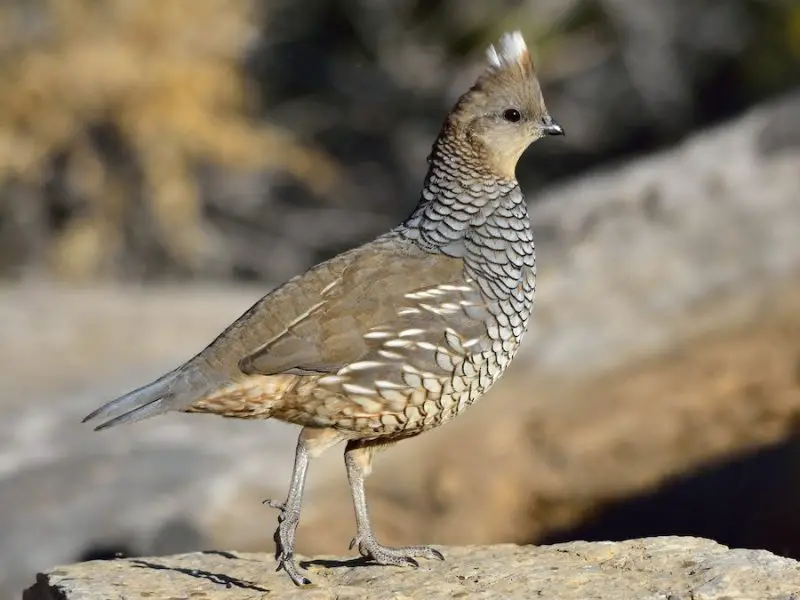
Though not a true dove, the Scaled Quail is sometimes mistaken for one due to its low, fluttering flight and plump body. It features bluish-gray plumage with scalloped or “scaled” feather patterns on its chest and back, along with a short crest on its head that resembles a small tuft. The bird typically runs rather than flies when disturbed.
Scaled Quail are ground dwellers that prefer arid grasslands, desert scrub, and mesquite flats. They feed on seeds, insects, and green vegetation, often forming coveys—small family groups—that stay together through much of the year. Their calls are loud, with a distinctive “chi-ca-go” whistle that carries well in open spaces.
In Texas, they are found primarily in the western part of the state, especially in the Panhandle, Trans-Pecos, and Edwards Plateau regions. These quail are common in suitable habitat but may be confused with ground-foraging doves by casual observers due to their similar movement patterns and habitat use.
Domestic Fancy Pigeon (Columba livia domestica)
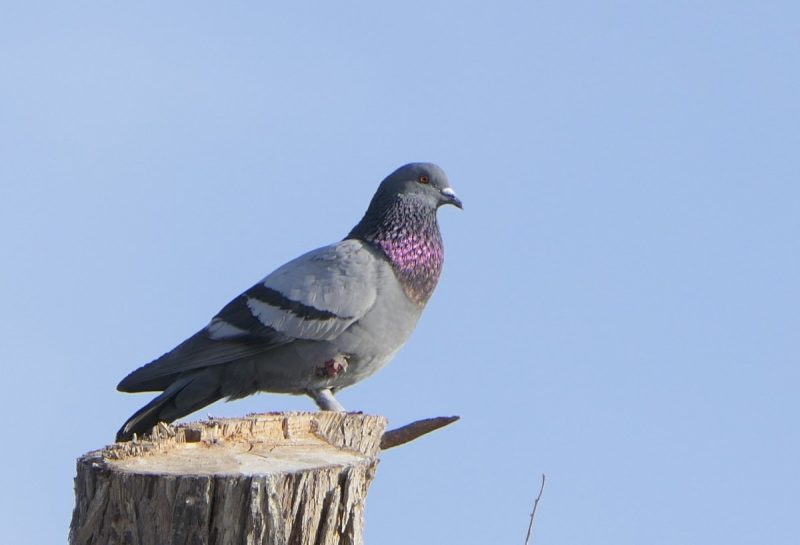
Domestic Fancy Pigeons are selectively bred varieties of the common Rock Pigeon and display a wide range of colors, feather shapes, and sizes. They can appear white, spotted, frilled, or crested depending on their lineage, making them distinct from wild pigeons. These birds are often raised for shows, racing, or as pets.
Although typically housed in lofts, some Domestic Fancy Pigeons escape or are intentionally released and may survive in the wild, particularly in urban environments. They often mix with feral Rock Pigeon populations, and their genetic traits may persist in hybrid offspring. Behaviorally, they are similar to Rock Pigeons—social, adaptable, and grain-eating.
In Texas, sightings of fancy pigeons are usually near cities or rural farms with pigeon enthusiasts. While not a self-sustaining wild population, their occasional presence adds variety to urban flocks. Their unusual plumage often makes them stand out when seen among more uniformly colored wild pigeons.
African Collared-Dove (Streptopelia roseogrisea)
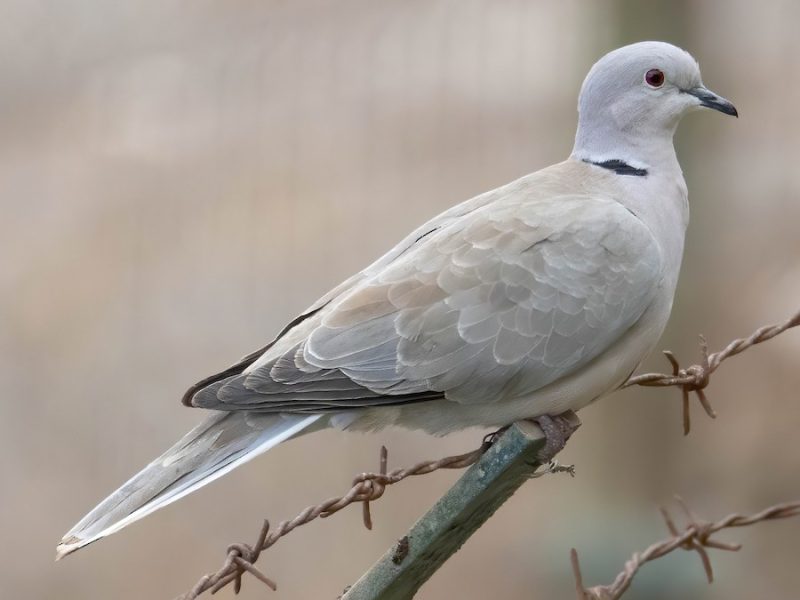
The African Collared-Dove is the wild ancestor of the domesticated Ringed Turtle-Dove. It has a pale grayish-buff body, a narrow black neck collar, and slightly pinkish tones on the chest. It resembles the Eurasian Collared-Dove but is smaller and typically lacks the darker outer wing edges seen in its cousin.
This species is not native to the Americas but can occasionally be found in the wild due to escape from captivity. African Collared-Doves are hardy and capable of surviving in dry, open environments with access to food and water. However, their presence in Texas is rare and usually limited to localized, short-term occurrences.
When they do appear in Texas, it’s usually near human habitation, bird feeders, or aviaries. Due to their close resemblance to other collared-dove species, accurate identification can be difficult without close observation. They are not known to form established wild populations in the state.
Band-tailed Pigeon (Patagioenas fasciata)

The Band-tailed Pigeon is a large, elegant pigeon with soft gray plumage, a pale head, and a distinctive white band across the nape of its neck. Its name comes from the dark band on its broad tail. The species has yellow legs and a yellow bill tipped with black, and its overall size is larger than a Rock Pigeon.
This pigeon typically inhabits mountainous conifer and oak forests in the western U.S., feeding on fruits, acorns, and seeds. It is known for its strong flight and deep, low-pitched calls that echo through forested canyons. It often travels in small flocks, particularly during fall migrations.
In Texas, the Band-tailed Pigeon is considered a very rare visitor, primarily recorded in the far western mountains of the Trans-Pecos region. Most sightings are sporadic and not indicative of a regular presence, making it a prized species for serious birders lucky enough to encounter one.
White-crowned Pigeon (Patagioenas leucocephala)
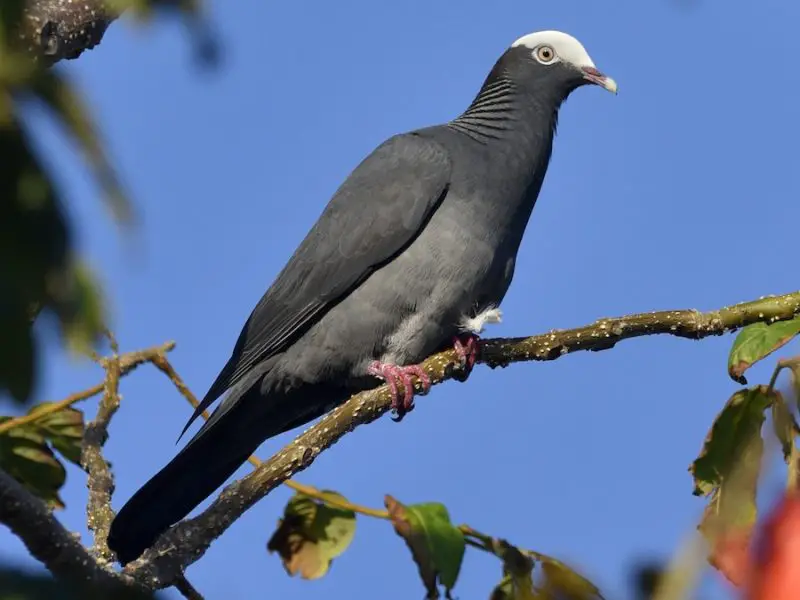
The White-crowned Pigeon is a sleek, tropical pigeon with a dark gray body, iridescent neck, and a striking white cap on its head. Its large eyes are surrounded by bare reddish skin, adding to its distinctive appearance. The bird is known for strong flight and shy, elusive behavior.
This species is typically found in coastal mangroves, subtropical hardwood forests, and island habitats, where it feeds on fruits and seeds from native trees. It nests in dense foliage and often commutes long distances between feeding and nesting sites. Its vocalization is a deep, booming “coo” unlike that of other pigeons.
In Texas, this species is an accidental visitor, with only a few rare records primarily along the Gulf Coast. These sightings are likely due to storm displacement or unusual weather patterns. While common in southern Florida and the Caribbean, it remains extremely rare in Texas and is not considered a regular part of the state’s avifauna.
Passenger Pigeon (Ectopistes migratorius)
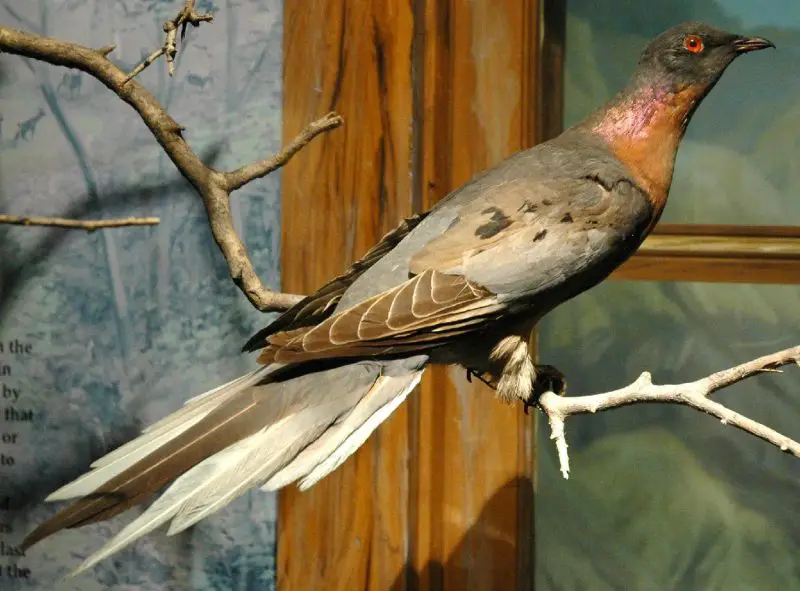
The Passenger Pigeon was once among the most abundant bird species in North America, known for forming flocks so massive they darkened the sky. It had a long tail, slate-blue back, and chestnut breast, with males more brightly colored than females. The species nested and traveled in vast colonies.
These pigeons primarily lived in deciduous forests and roosted in enormous numbers, feeding on acorns, chestnuts, and other forest mast. Despite their immense population, they were hunted relentlessly for food and sport. Habitat loss further accelerated their decline, leading to extinction by the early 20th century.
In Texas, historical records show that Passenger Pigeons once migrated through the eastern portion of the state in large flocks. However, the last confirmed wild individual was shot in 1901, and the final captive bird died in 1914. Today, they are remembered as a cautionary tale of human impact on wildlife.


